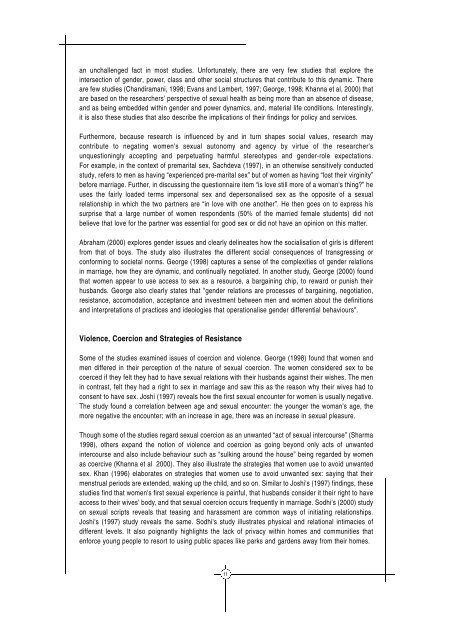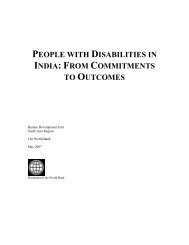FREE Download - TARSHI
FREE Download - TARSHI
FREE Download - TARSHI
You also want an ePaper? Increase the reach of your titles
YUMPU automatically turns print PDFs into web optimized ePapers that Google loves.
an unchallenged fact in most studies. Unfortunately, there are very few studies that explore the<br />
intersection of gender, power, class and other social structures that contribute to this dynamic. There<br />
are few studies (Chandiramani, 1998; Evans and Lambert, 1997; George, 1998; Khanna et al, 2000) that<br />
are based on the researchers' perspective of sexual health as being more than an absence of disease,<br />
and as being embedded within gender and power dynamics, and, material life conditions. Interestingly,<br />
it is also these studies that also describe the implications of their findings for policy and services.<br />
Furthermore, because research is influenced by and in turn shapes social values, research may<br />
contribute to negating women's sexual autonomy and agency by virtue of the researcher's<br />
unquestioningly accepting and perpetuating harmful stereotypes and gender-role expectations.<br />
For example, in the context of premarital sex, Sachdeva (1997), in an otherwise sensitively conducted<br />
study, refers to men as having “experienced pre-marital sex” but of women as having “lost their virginity”<br />
before marriage. Further, in discussing the questionnaire item “is love still more of a woman's thing?” he<br />
uses the fairly loaded terms impersonal sex and depersonalised sex as the opposite of a sexual<br />
relationship in which the two partners are “in love with one another”. He then goes on to express his<br />
surprise that a large number of women respondents (50% of the married female students) did not<br />
believe that love for the partner was essential for good sex or did not have an opinion on this matter.<br />
Abraham (2000) explores gender issues and clearly delineates how the socialisation of girls is different<br />
from that of boys. The study also illustrates the different social consequences of transgressing or<br />
conforming to societal norms. George (1998) captures a sense of the complexities of gender relations<br />
in marriage, how they are dynamic, and continually negotiated. In another study, George (2000) found<br />
that women appear to use access to sex as a resource, a bargaining chip, to reward or punish their<br />
husbands. George also clearly states that "gender relations are processes of bargaining, negotiation,<br />
resistance, accomodation, acceptance and investment between men and women about the definitions<br />
and interpretations of practices and ideologies that operationalise gender differential behaviours".<br />
Violence, Coercion and Strategies of Resistance<br />
Some of the studies examined issues of coercion and violence. George (1998) found that women and<br />
men differed in their perception of the nature of sexual coercion. The women considered sex to be<br />
coerced if they felt they had to have sexual relations with their husbands against their wishes. The men<br />
in contrast, felt they had a right to sex in marriage and saw this as the reason why their wives had to<br />
consent to have sex. Joshi (1997) reveals how the first sexual encounter for women is usually negative.<br />
The study found a correlation between age and sexual encounter: the younger the woman's age, the<br />
more negative the encounter; with an increase in age, there was an increase in sexual pleasure.<br />
Though some of the studies regard sexual coercion as an unwanted “act of sexual intercourse” (Sharma<br />
1998), others expand the notion of violence and coercion as going beyond only acts of unwanted<br />
intercourse and also include behaviour such as “sulking around the house” being regarded by women<br />
as coercive (Khanna et al 2000). They also illustrate the strategies that women use to avoid unwanted<br />
sex. Khan (1996) elaborates on strategies that women use to avoid unwanted sex: saying that their<br />
menstrual periods are extended, waking up the child, and so on. Similar to Joshi's (1997) findings, these<br />
studies find that women's first sexual experience is painful, that husbands consider it their right to have<br />
access to their wives’ body, and that sexual coercion occurs frequently in marriage. Sodhi's (2000) study<br />
on sexual scripts reveals that teasing and harassment are common ways of initiating relationships.<br />
Joshi's (1997) study reveals the same. Sodhi's study illustrates physical and relational intimacies of<br />
different levels. It also poignantly highlights the lack of privacy within homes and communities that<br />
enforce young people to resort to using public spaces like parks and gardens away from their homes.<br />
11










